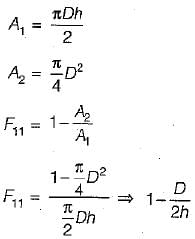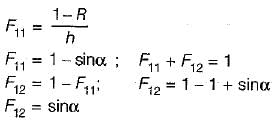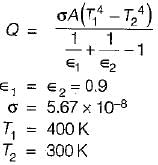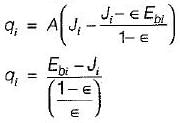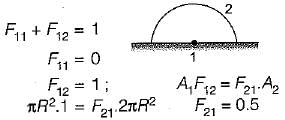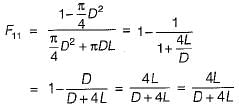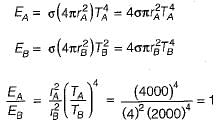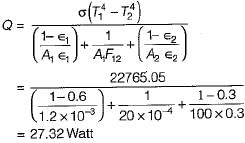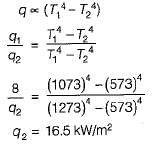Test: Radiation Heat Transfer - 3 - Chemical Engineering MCQ
30 Questions MCQ Test - Test: Radiation Heat Transfer - 3
According to Stefan Boltzmann law, the total radiation from a black body per second per unit area is proportional to
Absorptivity of a body is equal to its emissivity
The ratio of total emissive power of body to the total emissive power of a black body at the same temperature is called
Which one of the following is true for black body
Which one of the following is true for white body?
When metallic surfaces are oxidized, the emissivity
The solar energy falling on the earth’s surface is called
The shape factor F12 in case of a conical cavity having a semi vertex angle a and height h is given by
If the temperature of a solid surface changes from 27°C to 627°C. Its emissive power will increase in the ratio of
The radiative heat transfer rate per unit area (W/m2) between two plane parallel grey surface (emissivity = 0.9) maintained at 400 K and 300 K is (StefanBoltzmann constant s = 5.67 x 10-8 W/m2K4)
Two long parallel surfaces each of emissivity 07 are maintained at different temperature and accordingly have radiation heat exchange between them. It is desirable to reduce 75% of this radiant heat transfer by inserting thin parallel shields of equal emissivity on both sides. The number of shields should be
Heat transfer by radiation between two gre bodies of emissivity ∈ is proportional to (Notations have their usual meanings)
The shape factor of a hemispherical body place on a flat surface with respect to it self is
The shape factor of a cylindrical cavity with respect to it self is
A spherical body with surface A1 is completely enclosed by another hollow body with inner surface A2. The shape factor of A2 with respect to A1 is
For a circular tube of equal length and diameter shown below, the view factor F13 = 0.17. The view factor F12 in this case will be
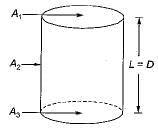
Two spheres A and B of same material have radii 1m and 4m and temperature 1000 K and 2000 K respectively. Which one of the following statement is correct.
The energy radiated by sphere A is
A plate having 10 cm2 area each side is hanging in the middle of a room of 100 m2 total surface area, the plate temperature and emissivity are respectively 800 K and 0.6. The temperature and emissivity values for the surface of the room are 300 K and 0.3 respectively. Boltzman’ constant σ = 5.67 x 10-8 W/m2K4. The total heat loss from the two surface of the plate is
Match List-I (surface with orientations) with List-lI (equivalent emissivity) and select the correct answer using the codes given below:
List-I
A. Infinite parallel planes
B. Body 1 completely enclosed by body 2 but body 1 is very small
C. Radiation exchange between two small Grey bodies
D. Two concentric cylinders with large lengths
List-II
1. ∈1
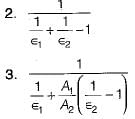
4. ∈1∈2
Codes:
A B C D
(a) 3 1 4 2
(b) 2 4 1 3
(c) 2 1 4 3
(d) 3 4 1 2
For the two long concentric cylinders with surface areas A1, and A2, the view factor F22 is given by

For a thin steel sheet, total emissive power is given as 32 W/m2, insolation as 93 W/m2. If thin sheet has reflectivity = 0,6, absorbtivity = 0.1 and transmissivity = 0.3. Then radiosity in W/m2
The thermal radiative flux from a surface of emissivity = 0 .4 is 22.68 kW /m2. The approximate surface temperature (K) is
Stefan Boltzmann's constant = 5.67x10-8 W/m2K4
A solid cylinder (surface 2) is located at the centre of a hollow sphere (surface 1). The diameter of the sphere is 1 m, while the cylinder has a diameter and length of 0.5 m each. The radiation configuration factor F11 is
Match List-I (Thermal spectrum) with List-l! (Wavelength mm) and select the correct aswer using the code given below the lists:
List-I
A. Cosmic rays
B. Radio waves
C. Visible light
D. UVrays
List-II
1. λ < 10-8
2. 102 < λ < 1010
3. 0.38 < λ< 0.78
4. 10-2 < λ < 0.38
Codes:
A B C D
(a) 4 2 3 1
(b) 2 1 3 4
(c) 4 3 2 1
(d) 1 2 3 4
Match List-I with List-ll and select the correct answer using the code given below the lists:
List-I
A. Window glass
B. Grey surface
C. Carbon dioxide
D. Radiosity
List-ll
1. Emissivity
2. Kinematic viscosity
3. Diffusion coefficient
Codes:
A B C
(a) 2 3 1
(b) 3 2 1
(c) 1 3 2
(d) 1 2 3
The radiation heat flux from a heating element at a temperature of 800°C, in a furnace maintained at 300°C is kW/m2. The flux when the element temperature is increased to 1000°C for the same furnace temperature is





